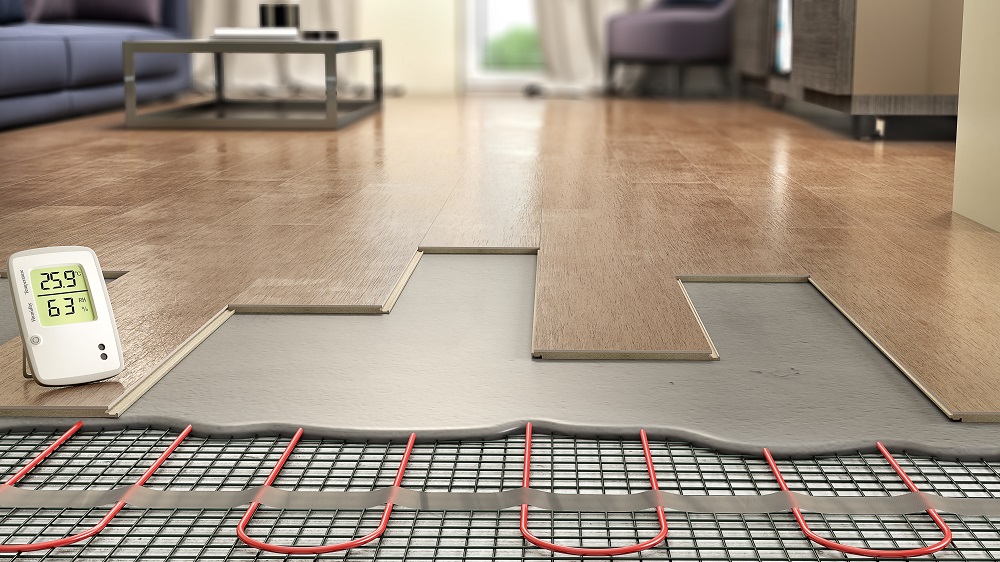If walking barefoot on a cold floor does not appeal to you, we’ve got you covered with our list of the warmest flooring types available. Plus, we’ll show you ways to make your existing floors warmer.
Solid and Engineered Timber
Along with its timeless look, timber flooring is an excellent heat conductor and helps heat travels through your home faster. This can help decrease energy costs and keep you feeling cosy on cooler nights.
Download our Ultimate Guide to
Understanding Timber Flooring
Laminate vs. Hybrid vs. Vinyl Flooring
We often get asked which is the warmest option between laminate, hybrid, and vinyl flooring. While all three of these options are neutral in terms of heat, meaning they are not necessarily warm or cool underfoot, the cosy factor comes down to what is around and underneath.
When it comes to these flooring materials, so much of the warmth underfoot will depend on the type of subfloor it is installed over, the thickness of the flooring itself, and the type of underlay used. Although these three types of flooring will perform fairly similarly in terms of warmth, laminate is at the top of the list of these three if cosy feet are a priority for you.
Laminate flooring has numerous benefits if you are looking for a floor that offers good insulation properties and has potential to feel warm underfoot.
Laminate flooring does not expand or contract from high temperatures, high moisture levels, or dry air, and works well with radiant heat systems. Being thicker than vinyl flooring, it is often more comfortable, especially when used with a high-quality foam underlay beneath. A high-quality, thick laminate flooring with a layer of dense foam padding will result in a cosy, comfortable walking surface.
Because some luxury vinyl planks include an integrated underlay and get installed directly over a concrete subfloor, they can feel colder since they lack insulation underneath. However, if you are set on ordering luxury vinyl flooring thanks to its amazing benefits (100% waterproof, durable and DIY-friendly, to name a few), ask us about maximising its warmth potential.
As with laminate and luxury vinyl planks, using a high-quality underlay beneath hybrid flooring — a mix of laminate and vinyl flooring — is important if you want to make it as cosy as possible.
Carpet
If feeling cosy is your top priority, carpet (and carpet tiles) reigns supreme. It feels inherently warm to the touch and does not pull heat from the body. It has been a popular choice for bedrooms, living room flooring, and family rooms for decades thanks to its plush, cosy feel.
How Can I Make My Floors Feel Warmer?
Any flooring can feel cosy with the right tricks. Here are some strategies to try if you are looking to make your existing floors feel warmer underfoot.
1. Add An Area Rug
If you are looking to make your existing floors feel warmer, one of the best options is adding a cosy area rug, such as those from our Bayliss range. This automatically adds warmth and comfort underfoot, with the added bonus of giving your room a mini-makeover by adding visual interest and making it seem more inviting.

A plush rug can add warmth (and style) to any room.
Excellent spots for area rugs include bedrooms, the living room, and hallways. You can also strategically position area rugs in places you are often barefoot, such as in front of your bathroom sink or next to your bed.
You may also consider storing the area rug away during the warmest times of the year (when you may welcome a cool sensation under your feet!) and bringing it out during cooler months. This makes it an easy way to customise your desires and give your room an update at the same time.
2. Let the Light In
Sunlight is also helpful, so consider opening up your blinds or curtains during the day to let the rays stream in and warm up the floors. At night, close your curtains or blinds to help retain any heat you collected. This technique works best with floors that conduct heat well, such as timber.
3. Show Your Home Some T.L.C.
The warmer your rooms are, the warmer your floors will feel. Seal any cracks or holes around doors and windows to prevent heat from escaping and cold air from entering. Adding insulation to your ceiling is another way to prvent drafts. If any of your exterior doors have slight gaps underneath, draft snakes placed at the bottom can act as an easy way to keep cold out air and warm air in.
The Importance of Underlay
Underlay acts as a temperature barrier between cold subfloors below and surface flooring above. It is especially effective with floors that take on the feel of what they are installed over such as vinyl, laminate, and hybrid flooring.
In addition to adding R-value to the floor and cutting down on energy costs, underlay can increase comfort and reduce sound transmission.
Underfloor Heat
If warmth underfoot is especially important to you, you may want to research a radiant below-surface heating system. This pricey yet effective option works by radiating heat through the underlay to the surface flooring and is one of the most effective ways to ensure a cosy surface beneath your feet.

A professional heating system underneath flooring can be expensive, but works well.
Looking for a Floor That Meets Your Style, Budget, and Comfort Needs?
If you would like to talk with us about which flooring material will best suit your needs, please feel free to reach out to our dedicated team.
We enjoy helping our customers on their journey to find the perfect flooring; from the beginning stages of research, to connecting you with quality tradesman throughout Australia for the installation process, to answering any care and cleaning questions that arise after!



